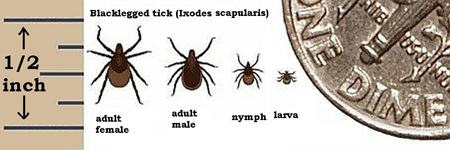



Ticks

Name: Brown Dog and Deer Ticks
Size: Young ticks have six legs, and mature ticks have eight legs. They are about the size of a sesame seed, and males are black; females have a brick-red abdomen with a black shield-like plate close to their head.
Habitat: Ticks are blood-feeding parasites that are often found in tall grass and shrubs where they will wait to attach to a passing host. A tick will attach itself to its host by inserting its chelicerae (cutting mandibles) and hypostome (feeding tube) into the skin. The hypostome is covered with recurved teeth and serves as an anchor. Physical contact is the only method of transportation for ticks. Ticks do not jump or fly, although they may drop from their perch and fall onto a host. Some species stalk the host by foot.
Prey: Dogs, people, rabbits, birds, deer and this tick also attacks sheep, horses, goats, and a few related species.
Danger:
Tick is the common name for the small arachnids in superfamily Ixodoidea that, along with other mites, constitute the Acarina. Ticks are ectoparasites (external parasites), living by hematophagy on the blood of mammals, birds, and occasionally reptiles and amphibians. Ticks are important vectors of a number of diseases, including Lyme disease, Q fever, Colorado tick fever, tularemia, tick-borne relapsing fever, babesiosis, ehrlichiosis and Tick-borne meningoencephalitis, as well as anaplasmosis in cattle and canine jaundice.

Some Links to information about ticks:
Photo Credits:
Tick - Scott Bauer, USDA (Public Domain).Tick Sizes - US Center for Disease Control (Public Domain).
The information on this page was taken from Wikipedia under a GNU Free Documentation License unless otherwise noted.









